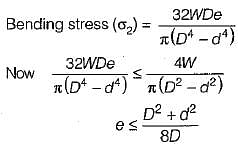Test: Struts & Columns - 3 - Mechanical Engineering MCQ
10 Questions MCQ Test Strength of Materials (SOM) - Test: Struts & Columns - 3
Compression members always tend to buckle in the direction of the
Euler’s formula gives 5 to 10% error in crippling load as compared to experimental results in practice because
| 1 Crore+ students have signed up on EduRev. Have you? Download the App |
Match List-I (Long column) with List-ll (Critical Load) and select the correct answer using the codes given below the lists:
List-I
A. Both ends hinged
B. One end fixed and other end free
C. Both ends fixed
D. One end fixed and other end hinged
List-II
1. π2 EI/4L2
2. 4π2 EI/4L2
3. 2π2 EI/4L2
4. π2 EI/L2
Codes:
A B C D
(a) 2 1 4 3
(b) 4 1 2 3
(c) 2 3 4 1
(d) 4 3 2 1
List-I
A. Both ends hinged
B. One end fixed and other end free
C. Both ends fixed
D. One end fixed and other end hinged
List-II
1. π2 EI/4L2
2. 4π2 EI/4L2
3. 2π2 EI/4L2
4. π2 EI/L2
Codes:
A B C D
(a) 2 1 4 3
(b) 4 1 2 3
(c) 2 3 4 1
(d) 4 3 2 1
Given that
PE = the crippling load given by Euler
Pc = the load at failure due to direct compression
PR = the load in accordance with the Rankine’s criterion of failure
Then PR is given by
If the crushing stress in the material of a mild steel column is 3300 kg/cm2. Euler’s formula for crippling load is applicable for slenderness ratio equal to/greater than
For a circular column having its ends hinged, the slenderness ratio is 160. The L/d ratio of the column is
When a column is subjected to an eccentric load, the stress induced in the column will be
An aluminium column of square cross-section (10 mm x 10 mm) and length 300 mm has both ends pinned. This is replaced by a circular cross-section (of diameter 10 mm) column of the same length and made of the same material with the same end conditions. The ratio of critical stresses for these two columns corresponding to Euler ’s critical load (σcritical) square : (σcritical)circular is
If one end of a hinged column is made fixed and the other free, how much is the critical load compared to the original value?
A short column of external diameter D and internal diameter d carries and eccentric load W. The greatest eccentricity which the load can be applied without producing tension on the cross-section of the column would be
|
37 videos|39 docs|45 tests
|
|
37 videos|39 docs|45 tests
|































